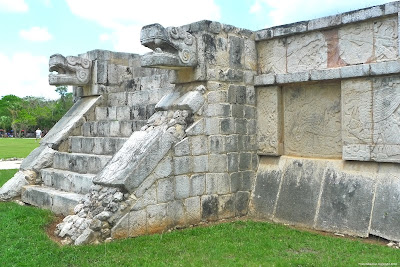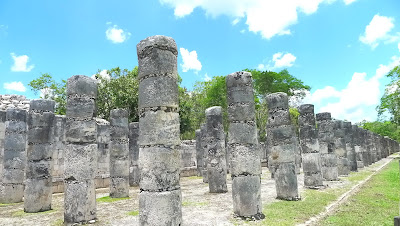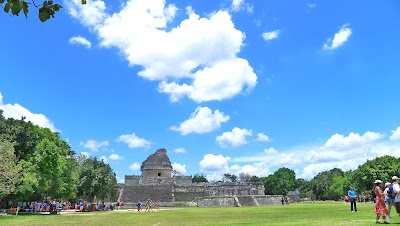Although there were many, the top contenders on where to go next were narrowed down to two - Tulum in the Riviera Maya, or the party hotspot, Cancun. I have been to Tulum before and even after two years, I still hold that place as one of the most beautiful and serene beaches I have ever sunk my toes in. It's bohemic, laid back, not grossly commercialized making it so heart-wrenchingly beautiful. I would have gone back there in a heartbeat. I have very little appetite for Cancun, but it is pretty accessible to one of the World's Seven Wonders and UNESCO World Heritage Site, the great Mayan ruins of Chichen Itza, which neither the Dutch nor I have seen yet. We figured, if the (misinterpreted?) Mayan prophecy comes true and the world ends on 12/21/12, then we might as well see Chichen Itza where the Mayan calendar was so revered. After having cappuccino at Cafe Mogagua, the self-proclaimed best coffee on the island, we hopped on a ferry for the twenty minute pleasant ride back to the big island. We're going to
Actually, Cancun is a lot more mellow than what I expected. We scored an amazing last-minute deal at Presidente InterContinental on Cancun's hotel zone, (thankfully) far enough from the gaudy tourist party hub. I had no right to complain. The beach right in front of our hotel was dazzling. I stifled a squeal as I ran towards the beach-front palapas, my bare feet sinking in the carpet of talcum powder sand, into the gorgeous, calm, turquoise waters that is the Caribbean signature.
Oh yeah, baby. Life is hecka good.



The following morning, we were picked up by the Grey Line shuttle at the hotel at 8 AM for our 3-hour foray to Chichen Itza. Transportation was about $35/roundtrip, exclusive of entrance tickets (which rang to about $20 a pop) but allows entrance to the ruins through a private gate via Mayalands Hotel. For about double that price, you could have a tour with a group led by a guide, a buffet lunch, and pool access at Mayalands before heading back to Cancun. We opted out of all that fluff since we had already made arrangements to meet with a private guide, Renee Tijsma. I personally would recommend hiring a qualified private guide when visiting archeological sites because they help bring to life what you see. Without someone knowledgeable pointing details out and giving contextual information, unless you have thoroughly studied the sometimes complex history of a place, you will be left looking at a pile of rocks, taking pictures, but never really get a sense that you understood anything. I think choosing a guide is a big decision, though, and I would recommend being selective. The last thing you want is to leave an important place and walking away with wrong information. We found Renee online and were attracted to her because she is Dutch. As the tour progressed, we realized what an excellent choice we made since it became obvious how extensive she has studied Mesoamerican history and culture, even attesting to having walked inside the ruins and describing to us what is contained in those sacred chambers. She was very articulate and had so many interesting historical accounts about the Chichen Itza and its Mayan inhabitants. She pointed out so many details that we would have missed, like the fading colors on the inside back limestone wall of the Temple of the Jaguars, or what the symbolism of the heirogliphics found inscribed on many of the temple walls meant. It was definitely worth the 600 pesos for the amount of information you get from someone who is educated and competent in the subject of Mayan history. I don't believe we would have such an enriching time exploring the ruins had we not been in her capable company!

There were so many fascinating things to ruminate about Chichen Itza. It blows my mind completely how it withstood destruction 1500 years after it was first erected. Thousands of years later, long after the Mayans have abandoned it, through all the migrations, natural disasters, foreign conquests, tribal wars, and extinctions, there it remains, still standing.
Equally flabbergasting is the fact that it was built on absolute, sophisticated, and stunning mathematical precision and symmetry. The human acumen and intelligence and what it is capable of creating is just incredible. What kind of ancient minds were these that were able to design a massive building with astounding symmetry AND to create the illusion of a slithering descent of the serpent god on its steps during the two equinoxes of the year? Each of the four sides of the “El Castillo” has 91 steps and if you add the top platform, you come up with 365, the number of days in the solar calendar. You can clap a few ways at the bottom of the pyramid and a certain rhythm would produce a sound resembling the quetzal, a sacred bird for the Mayans. Another clap variation would produce a sound resembling repeated chanting of "Kukulkan", the revered feathered serpent god. A few hundred feet from "El Castillo", there is a set of buildings believed to have been smaller scale models of the "El Castillo" and the Group of the One Thousand Columns. It is believed that this is a practice site of sorts where the Mayans perfected their structures' architectural elements. One could supposedly also witness the same light/shadow effect of the serpent god at sunset on the side of this smaller pyramid, similar to the one in the “El Castillo”, but on a different time of the year.

"El Castillo" in its stupendous glory

Temple that appears to be a smaller scale model of "El Castillo"
It is just amazing that “El Castillo” and all the amazing buildings in the compound that took many painstaking years to build (they said about 15,000 people over the course of three years) was built by hand and without the aid of any complex tools, not even the wheel. Without evidence of any contact with the Egyptian world, Mayans were able to build a structure that eerily resembles the pyramids of Giza. It makes me wonder if this suggests that intellectual evolution is universal and is an inevitability and eventual reality for all humankind.

"Platform of the Eagles"

The mural depicts a jaguar and an eagle eating human hearts.

"Juego de Pelota" or Main Ballcourt where players a game that sounds like a hybrid of basketball and soccer - except either the winner or loser (it's not quite clear) is sacrificed to the gods. A big heavy rubber ball is used and the object of the game is to shoot the ball in these rings on the side of the court without having the ball touch the ground. Only shoulders and torso are used to pass the ball around. This one is the biggest in all of America.

This carving on the wall of the ball court shows a presumed player holding the head of the presumed opponent

The majestic Temple of Thousand Columns

Columns that make up the Thousand

The Observatory is believed to be used for tracking astronomical events.

"La Iglesia" has walls with elaborate masks.

"The Nunnery" which is believed to be a King's Palace since they found what looked like actual small bedrooms inside.
What fascinates me the most about Chichen Itza is that all of this genius was related to the Mayans’ desire to please and worship their gods. It is a fascinating thought that the civilizations then and now were all founded on religion. Maybe the pursuit of God, of a higher being, regardless of what culture you hail from, is an innate, natural, inexplicable instinct for all humanity.

Photographed above is Cenote Sagrado which is the most popular cenote or sinkhole in the Chichen Itza compound. Where Chichen Itza sits in the Yucatan is an arid region and it is believed that Cenote Sagrado is where the Mayans offer sacrifices to the Mayan rain god, Chaac. If I remember from Renee, there have only been two successful attempts to explore the bottom of the Cenote Sagrado. One such attempt was by Edward Herbert Thompson in the early part of 1900 where he recovered human remains (evidence of human sacrifice – usually young boys, which once thrown in the cenote, survival was impossible) and precious stones such as jade.

The Mayan rain god Chaac. It is said that in his palms, human hearts are held as sacrifice.
On this trip, I was reading a book about Rumi and Shamz of Tabriz which struck me as another shining example of indestructibility. Shams is a Sufi mystic who lived in the 1200’s and he inspired Rumi to write poetry about love. Rumi’s work suffuses through the lives of seekers the world over to this day. According to Shams:
“East, west, south, or north makes little difference. No matter what your destination, just be sure to make every journey a journey within. If you travel within, you'll travel the whole wide world and beyond.”
For a second, let's assume that just as the Mayans predicted, life on earth will vanish in about six months. I ponder on my own life and imagine what kind of trace my life will leave behind. It is difficult to imagine. But then sometimes I think that this it – this blog contains the story of my life – all the mistakes and milestones, all its folly and humble glory, what I have seen, what I have experienced, where I have traveled - it is all contained here. I do not envision leaving a legacy comparable to the one left behind by the Mayans in the ancient city of Chichen Itza. But when I’m old and gray and when I’m dangerously a stranger to my own self, it will be enough for me to behold something real as I read through the pages of the familiar story of my own life.
This is my Chichen Itza.
Peace, love, and cartwheels,
Trish

No comments:
Post a Comment